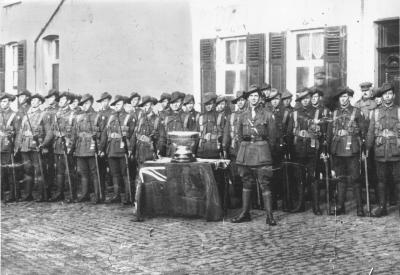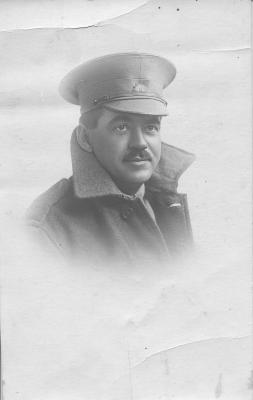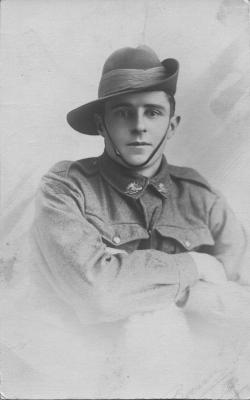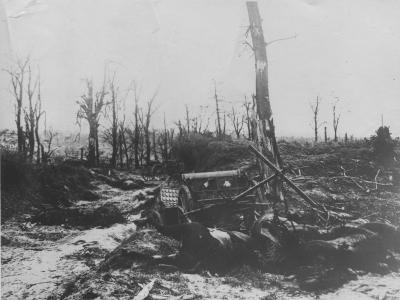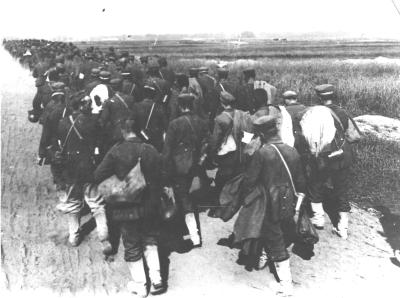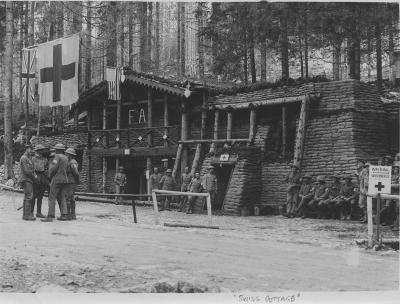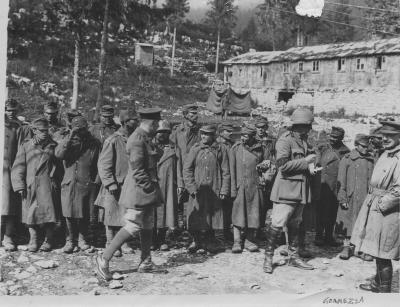World War 1, Europe, 3400 SPENCE, 52 Battalion, 1918
1918Studio portrait of 3400 Sergeant John Alexander SPENCE, DCM MM 52nd Battalion
The 52nd Battalion was raised at Tel el Kebir in Egypt in March 1916 as part of the "doubling" of the AIF. Approximately half of its recruits were veterans from the 12th Battalion, and the other half, fresh reinforcements from Australia. The 52nd was thus a mix of men from South and Western Australia and Tasmania. From March 1916, the battalion’s reinforcement groups mainly comprised men from Queensland. The 52nd became part of the 13th Brigade of the 4th Australian Division.
After arriving in France on 11 June 1916, the 52nd fought at Mouquet Farm on 3 September in a key assaulting role and suffered heavy casualties - 50 per cent of its fighting strength. The rest of the year and into 1917 alternated between front line duty, and training and labouring behind the line.
Early in 1917, the battalion participated in the advance that followed the German retreat to the Hindenburg Line, and attacked at Noreuil on 2 April. Later that year, the focus of AIF operations moved to the Ypres sector in Belgium. There the battalion was involved in the battle of Messines between 7 and 12 June and the battle of Polygon Wood on 26 September. Another winter of trench routine followed.
The 4th Division was deployed to defend positions south of the River Ancre during the March 1918 German offensive. At Dernancourt, on 5 April, the 52nd Battalion assisted in the repulse of the largest German attack mounted against Australian troops during the war. The German threat persisted through April, and just after 10pm on the 24th of April 1918, ANZAC Day eve, the 52nd began its advance in the now- legendary attack to dislodge the enemy from Villers-Bretonneux.
The defeat of the German offensive had come at a cost though. Due to heavy casualties and a lack of reinforcements from Australia, three brigades were directed to disband one of their battalions to reinforce the other three. The 13th Brigade was one of these, and on 16 May 1918 the 52nd Battalion was disbanded.
Details
Details
Open in Google Maps
Nearest geotagged records:
- World War 1, Australia, Western Australia, 248 SPENCE, 10 Light Horse (0.01km away)
- World War 1, Australia Western Australia, 8 Australian General Hospital, VAD, 1918 (0.36km away)
- World War 1, Australia Western Australia Fremantle, 8 Australian General Hospital, 1918 (0.36km away)
- Clydesdale horses at Wray Avenue, Fremantle. (0.43km away)
- McCallum family home back garden, 47 Wray Avenue, Fremantle. (0.43km away)
- McCallum family home front lawn, 47 Wray Avenue, Fremantle. (0.43km away)
- McCallum family home, 47 Wray Avenue, Fremantle. (0.43km away)
- Clydesdale horse at Wray Avenue, Fremantle. (0.45km away)
- World War 1, Australia, Western Australia, 3132 WYNNE, 10 Light Horse (0.51km away)
- World War 2, Australia Western Australia Fremantle, 1943 (0.53km away)
Nearby places: View all geotagged records »
Australian Army Museum of Western Australia
Australian Army Museum of Western Australia
Other items from Australian Army Museum of Western Australia
- World War 1, Europe, 51 Battalion, 1919
- World War 1, Australia Western Australia, 1914
- World War 1, Australia, 1915
- World War 1, Europe, 1919
- World War 1, Australia, 1915
- World War 1, Australia, 1916
- World War 1, Europe, 1917
- Pre 1914, 2nd Anglo Boer War, Western Australia, Fremantle, Western Australian Mounted Infantry, 1899
- World War 1, Europe, Western Front, German POWs,1917
- World War 1, Europe Italy, 1917
- World War 1, Europe Italy, 1917
- World War 1, Europe, 1917
